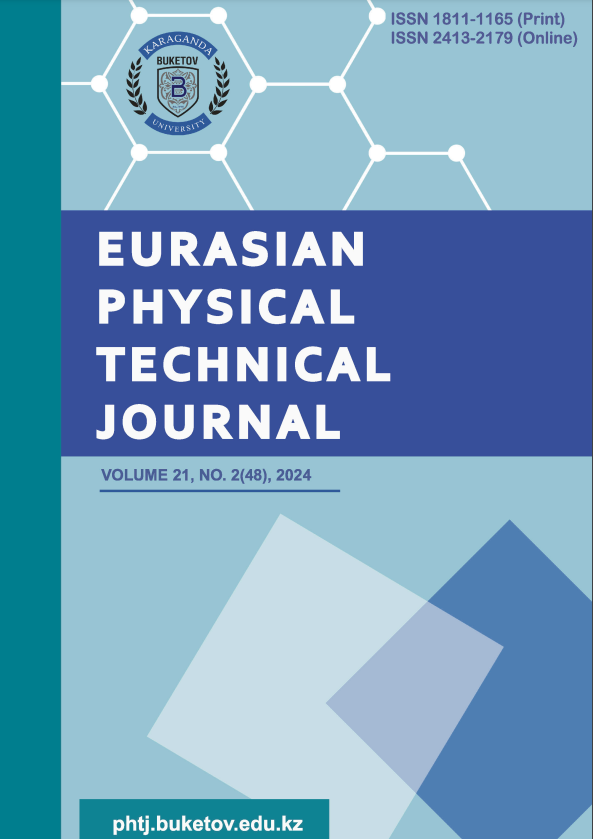INVESTIGATION OF CYCLIC PROPERTIES OF SOLAR AND GEOMAGNETIC ACTIVITIES: IMPLICATION FOR GLOBAL SURFACE TEMPERATURE VARIABILITY
DOI:
https://doi.org/10.31489/2024No2/102-111Keywords:
geomagnetic activity, solar activity, low-frequency cycle, grand episode, spectral power, global wavelet powerAbstract
The cyclic properties of solar-geomagnetic activity and global surface temperature have been investigated using trend, frequency and time-frequency analyses. Results reveal that on decadal-to-centennial timescales, low-frequency cycles in the half-century (~49 to 56 years per cycle) and Gleisberg (~99 to 114 years per cycle) range run in the background of the Schwabe (~9 to 11 years per cycle) as the dominant cycle of solar-geomagnetic activity. The only dominant cycle in the global surface temperature series is the half-century cycle and suggests a possible causal link between it and solar-geomagnetic activity phenomena. Evolution of the amplitudes of the cycles is such that the Schwabe and Gleisberg periods have increased in power from the beginning of the series until the mid-20th century after which they declined. The half-century cycle decreased in amplitude after 1800 to the present. For geomagnetic activity, the amplitude of Gleisberg cycle increased from the beginning of the series around 2000 while the amplitudes of Schwabe and half-century cycles declined within the same interval, except the Schwabe cycle which amplitude increased rapidly after 1980 to the present. For the global surface temperature, the amplitudes of Gleisberg and half-century cycles have continuously increased from the beginning of the series while Schwabe cycle oscillates with very low amplitudes until 1980 after which it increased slightly. Evolution of the amplitudes of cycles of solar-gemagnetic activity suggests a recovery from Maunder Minimum and decline into a grand epsode most likely to be a minimum.
References
Ibanga E.A., Agbo G. A., Inyang E. P., Ayedun F., Onuora L.O. (2020) Prediction of Solar Cycles: Implication for the Trend of Global Surface Temperature. Communication in Physical Sciences. 6(2), 882 – 890. Available at https://journalcps.com/index.php/volumes
Petrovay K. (2020) Solar cycle prediction. Living Rev Sol Phys. 17, 2-10. DOI:10.1007/s41116-020-0022-z(0123456789.
Kim J.H., Chang H.Y. (2014) Spectral Analysis of Geomagnetic Activity Indices and Solar Wind Parameters. Journal of Astronomy and Space Science. 31(2), 159 – 167. DOI: 10.5140/JASS.2014.31.2.159. DOI: https://doi.org/10.5140/JASS.2014.31.2.159
Okoh D.I., Seemala G.K., Rabiu A.B., Uwamahoro J., Habarulema J.B., Aggarwal M. (2018) Hybrid Regression-Neural Network (HR-NN) Method for Forecasting the Solar Activity. Space Weather. 16 (9), 1424-1436. DOI:10.1029/2018SW001907. DOI: https://doi.org/10.1029/2018SW001907
Hanslmeier A., Brajša R. (2010) The chaotic solar cycle I. Analysis of cosmogenic 14C-data. Astronomy and Astrophysics. 509, A5. DOI:10.1051/0004-6361/200913095. DOI: https://doi.org/10.1051/0004-6361/200913095
Peguero J.C., Carrasco V.M.S. (2023) A Critical Comment on “Can Solar Cycle 25 Be a New Dalton Minimum?” Solar Physics. 298: 48. DOI:10.1007/s11207-023-02140-7. DOI: https://doi.org/10.1007/s11207-023-02140-7
Kasde S.K; Sondhiya D.K., Gwal A.K. (2016) Analysis of Sunspot Time Series During the Ascending Phase of Solar Cycle 24 Using the Wavelet Transform. American Journal of Modern Physics. 5(5): 79 – 86.DOI:10.11648/j.ajmp.20160505.11. DOI: https://doi.org/10.11648/j.ajmp.20160505.11
Kristof P. (2020) Solar cycle prediction. Living Reviews in Solar Physics, 17: 2. DOI:10.1007/s41116-020-0022-z. DOI: https://doi.org/10.1007/s41116-020-0022-z
Muraki Y., Shibata S., Takamaru H., Oshima A. (2023) The 48-Year Data Analysis Collected by Ngoya Muon Telescope – A Detection of Possible (125±45)-Day Periodicity. Universe. 9, 372-387. DOI:10.3390/universe9090387. DOI: https://doi.org/10.3390/universe9090387
Torrence C., Compo G.P. (1998) A Practical Guide to Wavelet Analysis. Bulletin of the American Meteorological Society. 79(1), 61–78. DOI:10.1175/1520-0477(1998)079<0061:APGTWA>2.0.CO;2. DOI: https://doi.org/10.1175/1520-0477(1998)079<0061:APGTWA>2.0.CO;2
Riabova S. (2018) Application of wavelet analysis to the analysis of geomagnetic field variations. Journal of Physics: Conference Series. 1141:012146. DOI:10.1088/1742-6596/1141/1/012146. DOI: https://doi.org/10.1088/1742-6596/1141/1/012146
Liu Y., San Liang X., Weisberg R.H. (2007) Rectification of the Bias in the Wavelet Power Spectrum. Journal of Atmospheric and Oceanic Technology. 24, 2093–2102. DOI:10.1175/2007JTECHO511.1. DOI: https://doi.org/10.1175/2007JTECHO511.1
Cazelles B., Chavez M., Berteaux D., Menard F., Vik J.O., Jenouvrier S., Stenseth N.C. (2008) Wavelet analysis of ecological time series. Oecologia. 156 (2): 287–304. DOI: https://doi.org/10.1007/s00442-008-0993-2
Mohamed A.E., Eman S., Aly A., Shady E.M. (2010) Spectral Analysis of Solar Variability and their Possible Role on the Global Warming. Journal of Environmental Protection. 1, 111-116. DOI: https://doi.org/10.4236/jep.2010.12014
Downloads
Received
Revised
Accepted
Published online
How to Cite
Issue
Section
License

This work is licensed under a Creative Commons Attribution-NonCommercial-NoDerivatives 4.0 International License.













